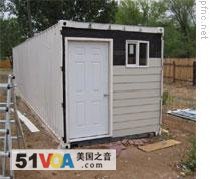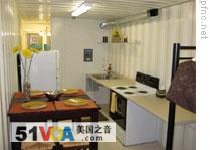2008-10-5
This is the VOA Special English Development Report.
An American named Malcom McLean invented a better box and changed the world. He designed the shipping containers that today carry most of the world's goods. Standardized containers can go on ships, trains or trucks and are easy to load and unload.
Malcom McLean was a truck driver who built a big trucking company. Then he bought a steamship company which he later renamed Sea-Land. He launched his idea in nineteen fifty-six using an old tanker.
 |
| A PFNC Global Communities home made from a shipping container |
A company called PFNC Global Communities has designed a steel container home for poor people. It has thirty square meters of space with a sleeping area, a bathroom and a kitchen. It also has connections for electricity and water, and special paint to help protect against the sun's heat.
Several years ago, a graduate business student named Brian McCarthy was visiting American companies in Ciudad Juarez, a border city in Mexico. He was there as part of his studies. He saw that many workers lived in shelters made of paper or scrap metal. More than a year later, he read about a house designed from a shipping container.
At the time, his cousin Pablo Nava was in his third year at Notre Dame University in the state of Indiana. Pablo Nava became interested in the project. He suggested that they enter the idea in a competition for business plans at the university. They won.
 |
| A look inside |
The sample home is twelve meters long and about two and a half meters in width and height. The kitchen has a stove to cook meals and a refrigerator to keep foods cold. Children and adults have separate sleeping areas.
The company hopes manufacturers in Ciudad Juarez will buy the homes for workers and their families. PFNC wants to keep the price below ten thousand dollars.
And that's the VOA Special English Development Report, written by Jerilyn Watson.